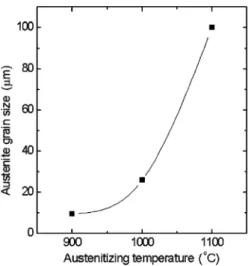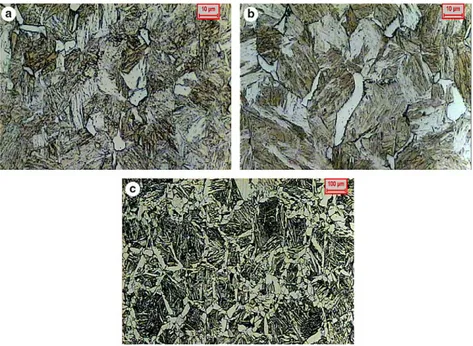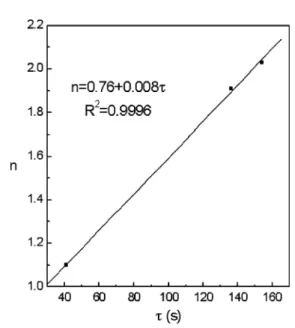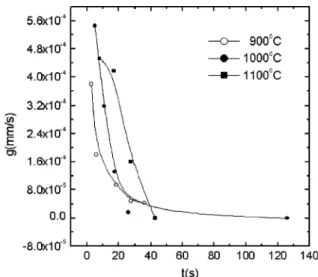Effect of the austenitizing temperature on the kinetics of ferritic
grain growth under continuous cooling of a Nb microalloyed steel
A.B. Cota
a,*, C.A.M. Lacerda
b, F.L.G. Oliveira
bF.A. Machado
b, F.G. da Silva Arau´jo
aa
Department of Physics/REDEMAT, Federal University of Ouro Preto, Prac¸a Tiradentes 20, Centro 35400000 Ouro Preto, Brazil b
REDEMAT, Federal University of Ouro Preto, Prac¸a Tiradentes 20, Centro 35400000 Ouro Preto, Brazil
Received 3 September 2003; received in revised form 21 May 2004; accepted 25 May 2004 Available online 3 July 2004
Abstract
The continuous cooling kinetics of the nucleation and growth of the ferritic phase was studied on a Nb microalloyed steel. John-son–Mehl–Avrami equations were found for three austenitizing conditions and a direct relation between the time exponent and the transformation time was revealed.
Ó2004 Published by Elsevier Ltd. on behalf of Acta Materialia Inc.
Keywords:Austenitizing; Nb microalloyed steels; Ferritic grain growth kinetics
1. Introduction
The austenite/ferrite transformation has been studied by many authors[1–4], as a function of the cooling rate, of the previous austenite grain size and of the degree of deformation on the non-recrystallization region.
The effect of the austenitizing temperature on the au-stenite transformation kinetics, for a Nb microalloyed steel, was studied by differential thermal analysis under continuous cooling. The authors demonstrated a strong dependence of the temperature for the beginning of fer-rite formation and of the transformation time on the au-stenitizing temperature, due to its effect on the austenite grain size[5].
Offerman et al.[6] studied the kinetics of the auste-nite/ferrite transformation by synchrotron X-ray diffrac-tion of individual grains, and confirmed the parabolic grain growth model, for the ferritic grains in the initial
transformation stages. Bengochea et al. [7] studied the evolution of the transformed fraction of deformed au-stenite into ferrite, under continuous cooling, based on an adaptation of the Johnson–Mehl–Avrami [8,9] the-ory. They were able to determine the average ferritic grain growth rate with the equation proposed by English and Backofen [10]. Their results show a decrease in the ferritic grain growth rate, as time increases.
This work analyzes the influence of the austenitizing parameters on the kinetics of nucleation and growth of the ferrite grains, during the continuous cooling trans-formation, for a low-carbon steel, microalloyed with Nb.
2. Experimental
The chemical composition of the steel under investi-gation, expressed in wt%, is 0.15C, 1.42Mn, 0.37Si, 0.052Al, 0.031Nb, 0.023P, 0.009S and 0.0042N. The samples were austenitized at 900, 1000 and 1100 °C,
for 30 min, in order to achieve different austenite grain sizes. They were subsequently cooled in air, before
1359-6462/$ - see front matter Ó2004 Published by Elsevier Ltd. on behalf of Acta Materialia Inc.
doi:10.1016/j.scriptamat.2004.05.044
* Corresponding author. Tel./fax: +55-313-559-1596. E-mail address:fgabriel@iceb.ufop.br(A.B. Cota).
quenching at temperatures between Ar3 and Ar1, the
temperatures for the start and finish of the austenite/fer-rite transformation. The reaction time,t, was measured from the instant the sample reached Ar3, until the
in-stant it was quenched. The transformation time, s, for each austenitizing temperature, was measured between Ar3and Ar1, in experiments in which the samples were
cooled in air until room temperature. The samples were etched with picric acid saturated solution, to reveal the austenite grain boundaries. The microstructural charac-terization was carried out by light and electron micros-copies, to determine the volume fraction and the average grain size of the polygonal ferrite and previous austenite, with the linear intercepts method. An etch with Nital 2% revealed the ferrite grains, formed before quenching, and the residual austenite, which turns into martensite.
3. Results and discussion
3.1. Austenite grain size
Fig. 1 shows the evolution of the average austenite grain size with the austenitizing temperature. For the sample austenitized at 1100°C, the austenite grain size
is much larger then for the samples austenitized at lower temperatures. This is a result of the dissolution of a large amount of niobium carbonitrides at that temperature. The niobium carbonitrides hinder the austenite grain boundaries, and inhibit the austenite grain growth, when the austenitizing is performed at lower temperatures.
3.2. Phase transformation temperatures
The temperatures for the start (Ar3) and finish (Ar1)
of the austenite/ferrite transformation were determined
by DTA [11] and the results are shown in Fig. 2, of the transformation temperature as a function of the au-stenitizing temperature. The Ar3temperature decreases
with an increasing austenitizing temperature. This is a result of the increased average austenite grain size achieved at higher temperatures. A larger austenite grain size leads to a decrease in the number of potential sites for ferrite nucleation, at the austenite grain boundaries, raising the driving force necessary for the transforma-tion.
Quantitatively, the austenite/ferrite transformation may be expressed in terms of Ar3, which is a parameter
related to the nucleation for the transformation, and of s, the transformation time [1]. Fig. 2 shows, together with the tendencies of the transformation temperatures, the dependence of the transformation time with the au-stenitizing temperature. Higher auau-stenitizing tempera-tures imply longer transformation times. This is a result of the increased austenite grain sizes, which de-crease the Ar3 temperature, delaying the beginning of
the austenite/ferrite transformation. Lower Ar3
temper-atures imply that the transformation occurs at lower rates, once there is less energy available to activate the reaction and reduced diffusion of carbon. Also, at lower temperatures, the cooling rate in air is lower. Another reason for the increase in the transformation time is the increase in dissolved Nb that segregates in the auste-nite/ferrite boundary, slowing it down [1].
3.3. Microstructural evolution and kinetics of ferrite formation
Fig. 3 shows photomicrographs of Nb microalloyed steel samples, austenitized at 900, 1000 and 1100 °C,
continuous cooled in air, and quenched from tempera-tures inside the ferrite–austenite region. For the samples
Fig. 1. Effect of the austenitizing temperature on the average austenite grain size, for a Nb microalloyed steel.
Fig. 2. Temperatures for the start (Ar3) and finish (Ar1) of the
austenite/ferrite transformation, and transformation time (s), as a
function of the austenitizing temperature, for continuous cooling in air.
austenitized at 900 and 1000 °C, the microstructure is
composed of polygonal ferrite and martensite. In these samples, upon quenching from temperatures close to Ar1, some pearlite was also formed. The microstructure
of the samples austenitized at 1100 °C is, basically,
polygonal ferrite, martensite and bainitic ferrite, accord-ing to the classification proposed by Krauss and Thompson[12].
The ferrite volume fractions, measured in the samples quenched in water at room temperature, increased with the decreasing of the temperature of interruption of the continuous cooling. Fig. 4 shows the polygonal ferrite
volume fraction, fa, as a function of the reaction time,
t, for the three austenitization temperatures. The data were fitted to the Johnson–Mehl–Avrami [8,9] model, expressed by Eq.(1):
fa¼A½1expðBt
nÞ ð1Þ
whereA,Bandnare constants determined in the curve fitting of the ferrite volume fraction as a function of the reaction time. The fitted semi-empirical equations are listed in Table 1, for the three austenitizing tempera-tures, together with the correlation coefficients, and the transformation times of austenite to ferrite under continuous cooling.
A closer look into the parameters adjusted for the Johnson–Mehl–Avrami equation, for the Nb microal-loyed steel, reveals a linear relation between the time exponent in the equation, n, and the transformation time under continuous cooling, s. This is shown in Fig. 5, of the coefficientnas a linear function ofs, with a correlation coefficient above 0.999. It reveals a partic-ular feature of this empirical equation, valid at least for the steel in question that allows the prediction of the transformation time under continuous cooling, directly from the time exponent. Despite the obvious relation be-tween the two values, the relation bebe-tween them could be non-linear, had AandB values different from those found.
The ferrite grain growth rate may be estimated from Eqs. (2)–(4), together with the equation proposed by English and Backofen[10]:
g¼ 1
Sv
dfa dt
ð5Þ
Fig. 3. Photomicrographs of Nb microalloyed steel samples, continuous cooled in air after: (a) austenitizing at 900°C and quenched at 755°C; (b) austenitizing at 1000°C and quenched at 720°C; (c) austenitizing at 1100°C and quenched at 588°C.
Fig. 4. Ferrite volume fraction,fa, as a function of the reaction time,
wheregis the ferrite grain growth rate,Svis the surface area of the austenite/ferrite phase boundary per unit vol-ume andfais the volume fraction of ferrite at timet.
The surface area of the austenite/ferrite phase bound-ary per unit volume is shown inFig. 6as a function of the ferrite volume fraction. It is observed that the higher the austenitizing temperature, the smaller the phase boundary surface area, as a result of the larger austenite grain sizes. A maximum is observed for theSvversusfa plot, establishing the value at which the growing ferrite grains start to touch each other.
Fig. 7shows the ferrite grain size,da, as a function of the reaction time, for the three austenitizing tempera-tures. Higher austenitizing temperatures lead to larger ferrite grain sizes. The larger austenite grain sizes, pro-duced by the higher austenitizing temperatures, decrease the surface area for the nucleation of the ferrite grains, what leads to the production of larger grains. The effect is much more pronounced at the austenitizing tempera-ture of 1100°C, as a result of the secondary growth of
Fig. 6. Surface area of the austenite/ferrite phase boundary per unit volume,Sv, as a function of the ferrite volume fraction,fa, for the
austenitizing temperatures of 900, 1000 and 1100°C.
Fig. 7. Ferrite grain size, da, as a function of the reaction time, for the
three austenitizing temperatures of 900, 1000 and 1100°C. Table 1
Semi-empirical equations for the kinetics of austenite/ferrite transformation, of a Nb microalloyed steel, under continuous cooling
Austenitizing temperatures Equation Correlation coefficient (R2) Transformation time
900°C f
a¼0:82½1expð0:05t
1:1Þ ð2Þ 0.9647 41 s
1000°C fa¼0:84½1expð0:01t
1:91Þ ð3Þ 0.9584 136 s
1100°C fa¼0:31½1expð0:001t
2:03Þ ð4Þ 0.9784 154 s
Fig. 5. Johnson–Mehl–Avrami time exponent, as a function of the transformation time,s, under continuous cooling of a Nb microalloyed
steel.
the austenite grains, caused by the dissolution of the Nb precipitates.
The coarse polygonal ferrite grain size in the speci-men austenitized at 1100 °C can be explained by the
longer reaction times, shown inFig. 2, despite the fact that Ar3 and Ar1 are at lower temperatures. Grain
boundary nucleation between Ar3and Ar1, for this case,
results in a smaller number of nuclei, and the longer reaction times provide the polygonal ferrite coarsening. The grain boundary nucleation sites appear to be satu-rated early only for the specimen austenitized at 1100
°C, because of the smaller interfacial area available.
Fig. 8shows the average grain growth rate,g, as cal-culated from Eq.(5), as a function of the reaction time, for each austenitizing temperature. There is a decrease in
g with the reaction time, once longer times correspond to lower temperatures, at which the atom diffusion de-creases. The increase ingwith the austenitizing temper-ature is a result of the smaller degree of grain impingement, together with the lowering of Ar3that
in-creases the driving force for the reaction.
4. Conclusions
For the Nb microalloyed steel analyzed, the increase of the austenitizing temperature, from 900 to 1100 °C,
decreases the Ar3 temperature from 755 to 668 °C,
approximately, for continuous cooling in air, and in-creases the austenite grain size from 9.5 up to 100lm.
Also, it increases the average ferrite grain size from 8 to about 40 lm, at the end of the reaction, as well as
it increases the ferrite grain growth rate.
Semi-empirical equations, for the ferrite transformed fraction as a function of the reaction time, for the au-stenitizing temperatures of 900, 1000 and 1100 °C,
re-vealed that, for the Nb microalloyed steel under study in continuous cooling, the time exponent has a linear relation with the transformation time.
Acknowledgments
The authors are grateful for the financial support of CNPq, FUNDAC¸ A˜ O GORCEIX and FAPEMIG.
References
[1] Manohar PA, Chandra T, Killmore CR. ISIJ Int 1996;36:1486. [2] Thompson SW, Krauss G. Metall Mater Trans A 1996;27A:1557. [3] Cota AB, Santos DB. Mater Charac 2000;44:291.
[4] Velthuis SGE, Dijk NH, Rekveldt MTh, Siestsma J, Zwaag S. Mater Sci Eng 2000;A277:218.
[5] Cota AB, Lacerda CAM, Oliveira FLG, Araujo FGS. REM 2002;55:273.
[6] Offerman SE et al. Science 2002;298:1003–5.
[7] Bengochea R, Lo´pez B, Gutierrez I. Metall Mater Trans A 1998;29:417.
[8] Johnson WA, Mehl RF. Trans AIME 1939;135:416. [9] Avrami M. J Chem Phys 1941;9:177.
[10] English AT, Backofen WA. Trans Metall Soc AIME 1964;230:396.
[11] Cota AB, Modenesi PJ, Barbosa R, Santos DB. Scripta Mater 1999;40:165.
[12] Krauss G, Thompson SW. ISIJ Int 1995;35:937. Fig. 8. Average grain growth rate,g, as a function of the reaction time,



